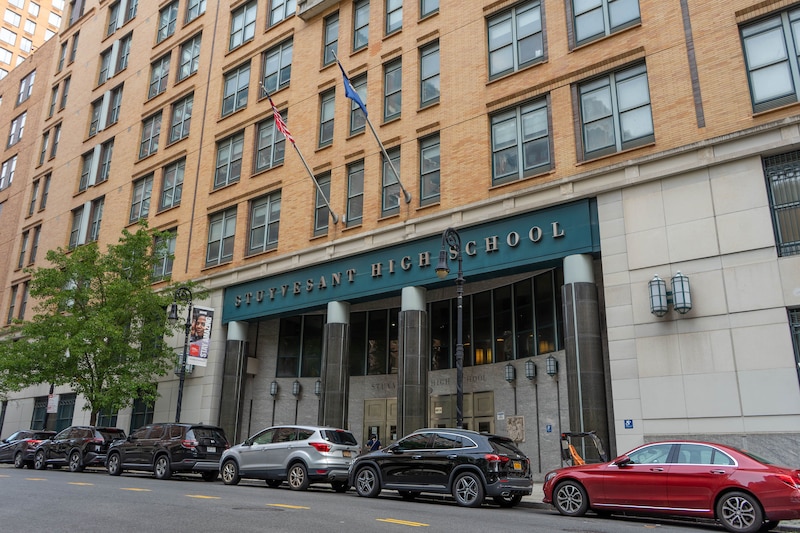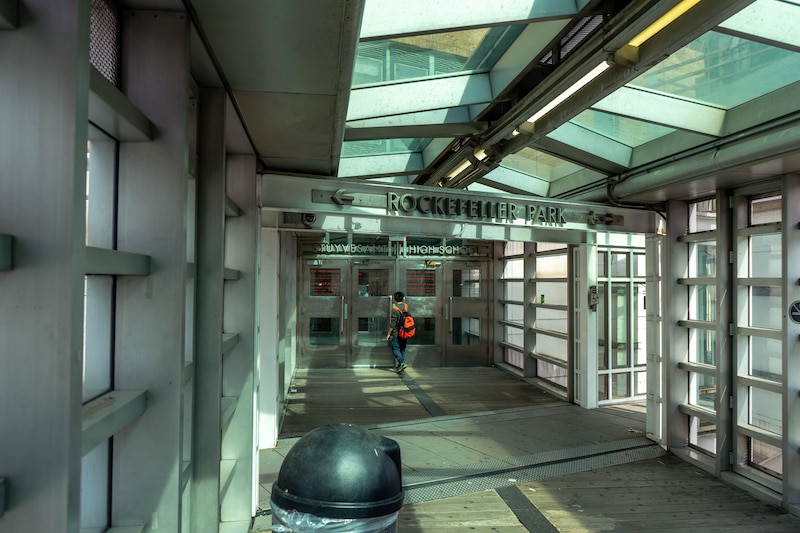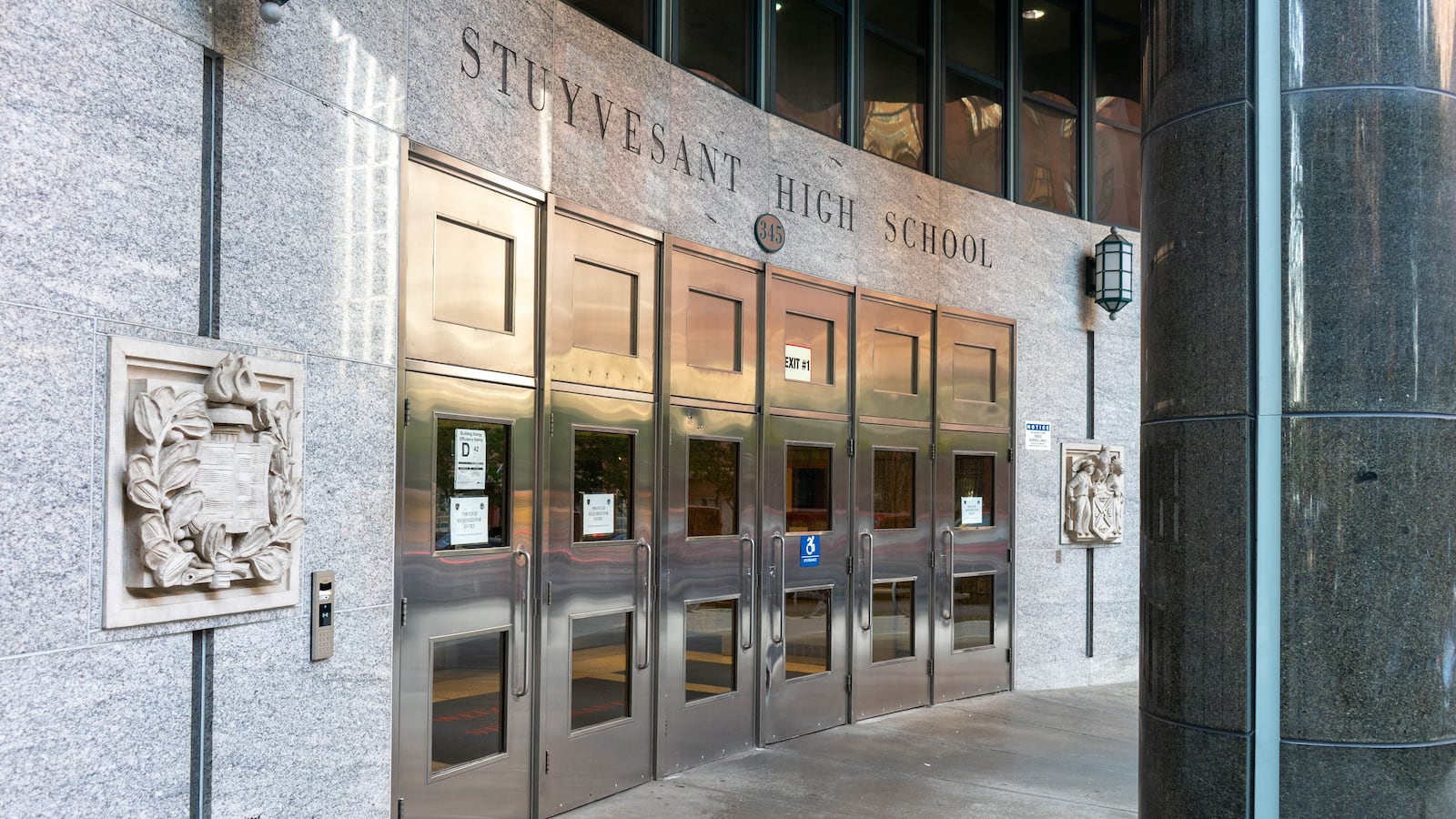In the summer after middle school, George begged his mom to drive him to Lower Manhattan from their home in Brooklyn, so that he could walk around Stuyvesant High School, a massive 10-story building along the Hudson River.
He gazed up at it, trying to imagine what it would be like to go to one of New York City’s most prestigious institutions.
“I had this idea in my head of what Stuyvesant would be like,” he said, recalling that summer three years ago. “I’ve always been kind of a sucker for those big things.” (George and his mother requested pseudonyms for privacy reasons.)
George had attended gifted and talented programs, excelling in those environments, and seemingly was the type of student that Stuyvesent is built for. Yet students like him rarely attended.
George has a learning disability, attention deficit hyperactivity disorder, or ADHD. In middle school his individualized education program, or IEP, called for him to be in a classroom integrating students with and without disabilities co-taught by two teachers: one general education or subject specialist, and one special education teacher. He also received additional support, like guided notes and specialized counseling to help him stay organized and work on strategies to stay on task.
The accommodations he needed would greatly complicate his Stuyvesant dream.
At the city’s eight specialized high schools requiring an exam as the sole basis of admission, students classified with disabilities represent a staggeringly small share of the population, much lower than the average at high schools citywide. In fact, the specialized high schools rank close to the bottom or last, according to the Education Department data from the 2022-23 school year.
In some ways, this is by design: The specialized schools are the only high schools in the system not required to set seats aside for students with disabilities. Moreover, specialized high schools, directly and indirectly, have for decades discouraged students with learning disabilities from coming to their schools, according to advocates and parents as well as legal complaints filed on behalf of students. At some specialized high schools, students with disabilities barely eclipse 1% of the total population, Education Department data showed.
Across all high schools in the city, 1 of every 5 students are mandated to receive special education support under an IEP. At specialized high schools, that number is only 1 of 50.
For the few who do make it, some families say they are forced to battle with school officials to receive their legally mandated accommodations, struggling to stay afloat in an environment of intense workloads and high expectations.
Teachers and administrators at specialized high schools declined to comment after repeated requests.
“Entrance requirements to these schools are set by state law,” said Education Department spokesperson Nathaniel Styer, declining to address specific allegations. “If a student has services on their IEP, then they get those services. If they do not have services on their IEP or an IEP, they don’t get services.”
While the specialized high school admissions test, or SHSAT, has long been blamed for the lack of racial diversity at these schools, it also has locked out students with disabilities. Students with IEPs were three times less likely to sit for the SHSAT than their peers without disabilities, according to an Independent Budget Office analysis of 2021 data done at the request of Chalkbeat. And when it came to getting an offer, that disparity only grew. Test takers with disabilities were 11 times less likely to get an offer than their peers, an acceptance rate of 0.6%.
Of the more than 3,600 students admitted to the eight specialized high schools, only 80 eighth graders with disabilities got in. Last year, outcomes for students with disabilities were slightly worse: just 76 students received an offer to a specialized high school, according to data obtained through a public records request.

Before the high school decision deadline, in a meeting with Stuyvesant’s assistant principal for special education and a social worker, George’s parents were pushed to drop co-teaching from his IEP, they said. The administrators told the family that many students at Stuyvesant often “graduate” out of those accommodations, and when told that George had also been admitted to another school, they suggested that George would be better off going there.
“We could already tell that there would be trouble,” said Elizabeth. “It’s just kind of like this culture of denial: If you’re at Stuyvesant, and you’ve made it this far, that means that you don’t need the support.”
His mother, however, did not give up. She said George was the first student at Stuy to receive classes co-taught with a special education teacher. The two special education teachers on staff had to bounce from class to class and teach multiple subjects throughout the school day.
Despite their reservations, as he entered the doors of Stuyvesent at the start of his freshman year, George remained optimistic about his future there.
Lack of services, lack of students with disabilities at specialized high schools
In 2012 the city established a policy to set aside seats for students with disabilities at selective high schools that use GPAs and other measures to screen students. Within a few years, not only did the number of students with disabilities increase, but access to co-teaching classes and special education support classes became far more common at these top schools.
Specialized high schools were exempted from this policy.
The small number of students with disabilities is also reflected in the specialized high schools’ budgets. According to school budget documents obtained from the Education Department, specialized high schools spend far less on special education than other schools. Because funds from the city for special education are need-based, fewer students with disabilities means less money to hire teachers and provide services.
Bronx Science only has one dedicated special education teacher, and at Stuyvesant, there are only four, budget figures show. Both schools serve about 3,000 students. Schools with comparable numbers of students, such as Bayside High School or Susan E. Wagner High School, each have 30 or more special education teachers. At smaller selective schools like Beacon (roughly 1,500 students) and Townsend Harris (about 1,300 students), there are 14 and 20 special education specialists, respectively.
In the last school year, out of the more than 18,000 students at specialized high schools, only 76 students had co-teaching on their IEP, and 108 had special education support classes, according to DOE data obtained through a freedom of information request.
Families and advocates say some school officials have said co-teaching classes can’t be provided. Some schools also try to persuade parents to drop parts of their child’s IEP, or drag out discussions in the hopes that parents either capitulate or choose a different school, they said.
Jenn Choi, an advocate who has represented parents in IEP meetings at multiple specialized high schools, said it is easier for administrators to encourage students to remove the more expensive accommodations from IEPs, or convince students not to attend the school at all.
“What we have to remember is that the students are not asking for lower standards. They’re only asking for access,” said Choi. “They’re just not understanding that they have to learn how to teach differently.”
With limited funding for special education, specialized high schools would potentially need to divert money from other programs to hire enough staff to support special education services adequately. Choi said that with that funding model, the problem will continue.
“It was like a piece of reality that kind of like, fell on top of him at that moment,” said Maria Torres Quiles, whose son was told by Brooklyn Tech special education teachers that they would not provide co-teaching services in 2019. “He was so crushed.”
She decided not to fight Brooklyn Tech for the services, choosing to send him to Manhattan’s NEST+m High School, another selective school, instead.
Parents feel pressured to downgrade support for students with disabilities
Sandra Cheng’s daughter, a recent Stuyvesant graduate with an IEP, had a stroke in 2019 during her last year of middle school, causing her to lose the ability to read and speak, and resulting in paralysis in one half of her body. It was after she had been offered a spot at Stuyvesant, which she accepted.
During lockdown in the first year of the COVID pandemic, Cheng was able to support her daughter by reading texts and writing for her at home.
Once her daughter returned to in-person school, however, teachers began questioning or ignoring accommodations in her IEP. Some officials at Stuyvesant suggested that her daughter drop out and have the DOE pay for private special schooling, Cheng said. Others suggested that asking for accommodations was a way to cheat the system or gain an advantage.

Cheng, an alumna of Stuyvesant herself, attributed some pushback from teachers to a larger cultural problem at the school. She thought that in an effort to uphold high standards, teachers were often inflexible and expected students to keep up with the strenuous pace.
But things are slowly starting to change at Stuyvesant, Cheng believes. Parents of students with disabilities have formed a sub-group within the larger structure of the parents’ association, advocating for changes collectively. The school recently hired a new assistant principal of special education.
As Cheng’s daughter grappled with school and recovering from her stroke, George began his freshman year. From the start adherence to his IEP was uneven, with some teachers being better than others, Elizabeth said.
Elizabeth described her son’s freshman year as a cycle of burnout and then a crazy push to catch up as George labored to hang on to a grade point average good enough for a top college. At the beginning of the year, George joined several clubs. But he soon stopped having time for anything other than school work, with about four hours of nightly homework — and he was still falling behind.
Meanwhile, in IEP meetings, Stuyvesant officials pressured Elizabeth to scale down George’s support, she said.
By the end of his freshman year, George dreaded going to school each morning. His optimism was gone.
When George returned sophomore year, he continued to struggle. He and his mother were exhausted, and the prospect of three more years of constantly battling with administrators and teachers — “trench warfare,” as George put it — did not seem worth the ongoing emotional anguish.
In the fall of 2022, he said goodbye to his teachers and friends, and dropped out in the middle of the semester.
George’s family had the financial means for an alternative to the public school system, which is a luxury few have. (For privacy reasons, the family didn’t want to share George’s current school.)
After George left Stuyvesant, Elizabeth filed a civil rights complaint against the school with the U.S. Department of Education, which Chalkbeat reviewed.
Yet she may have a long wait. Another Office of Civil Rights complaint against Brooklyn Tech brought in 2021 is still awaiting adjudication. The suit alleges that officials illegally delayed or denied students’ evaluation for IEPs, said Miriam Nunberg, an attorney who filed a joint suit on behalf of five families.
George said he was proud of going to Stuyvesant.
But, “I never really felt like I was wanted there.”
Brendan Rose is a New York City-based journalist. He attended the Bronx High School of Science, and he reported this story while at Columbia University’s Graduate School of Journalism.

